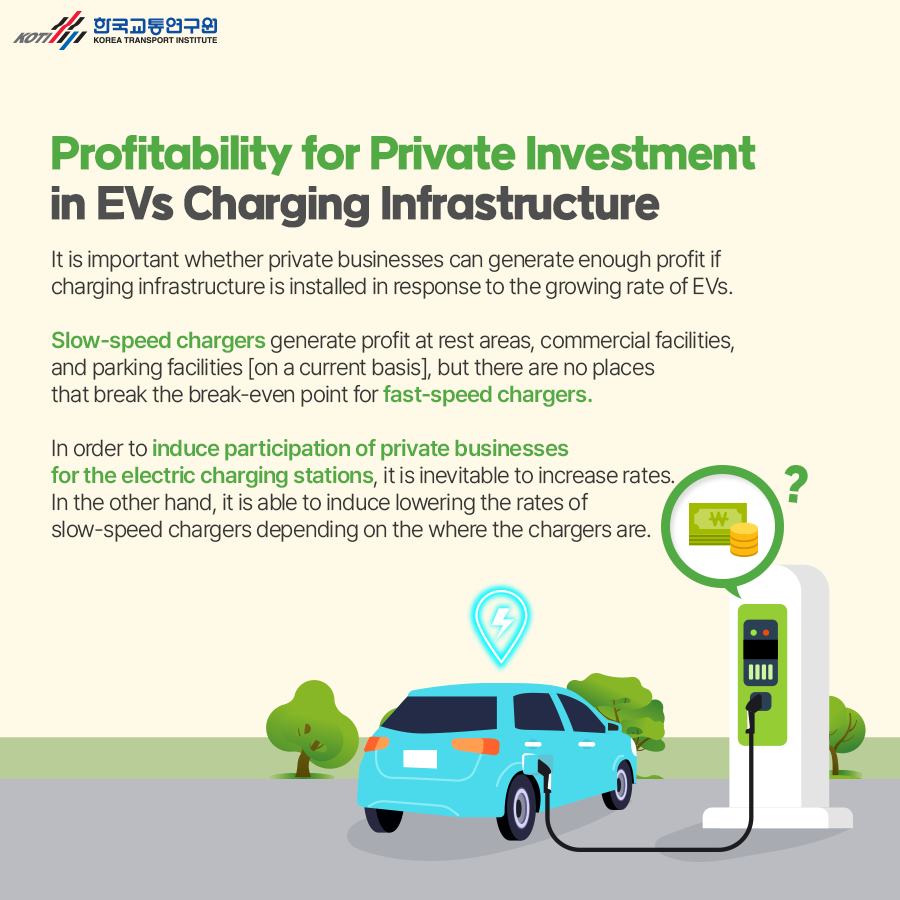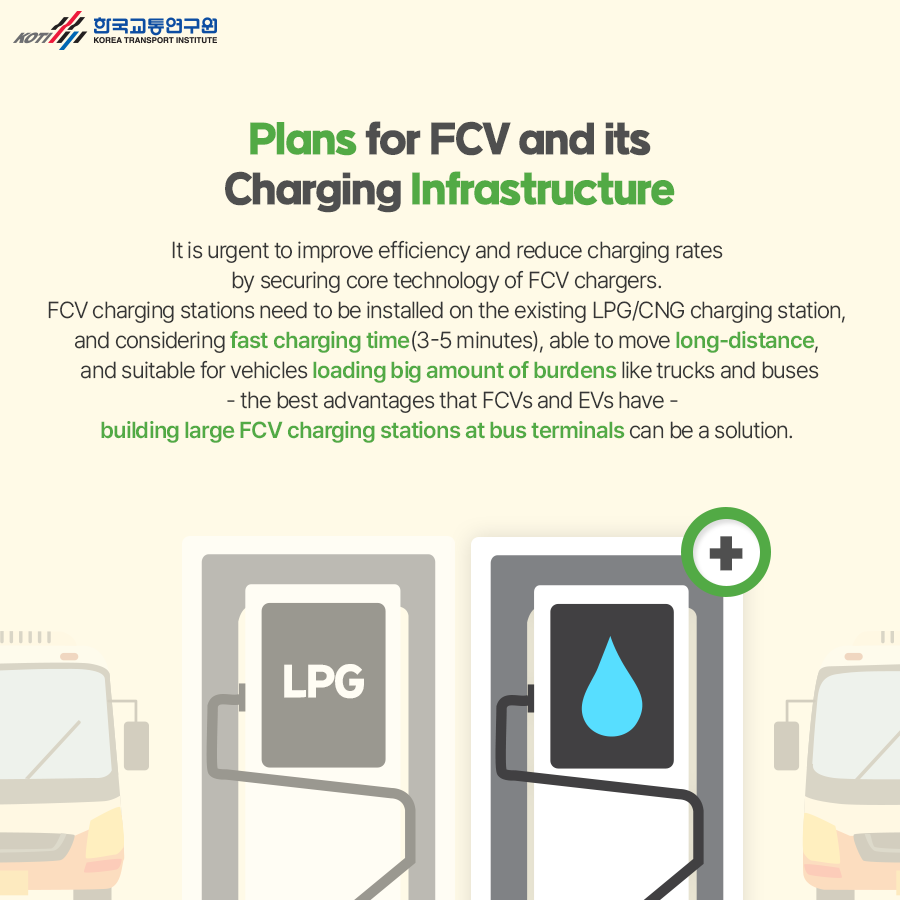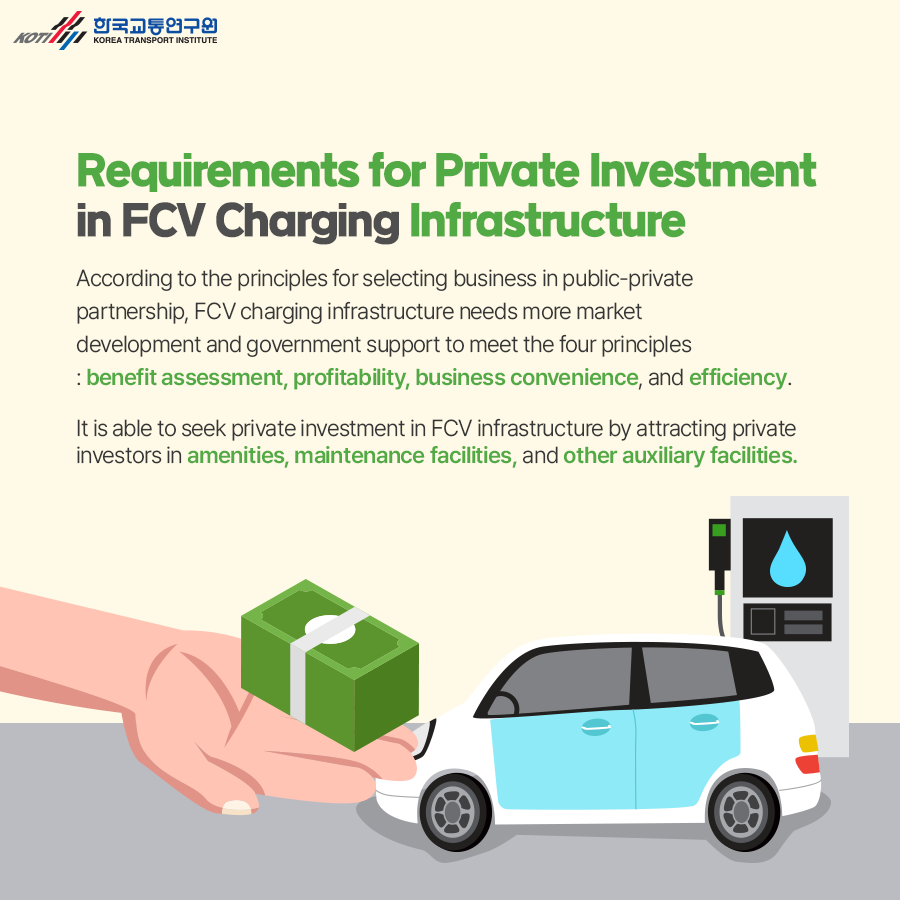Card News

NEWS
KOTI - Korea Transport institute-
Insufficient Stations for Hydrogen Fuel Cell Vehicles and Electric Vehicles -- Can't We Build More?
# The government announced 2050 Net Zero Carbon Emission, and after electric vehicles are supplied, people use hydrogen fuel cell vehicles (FCVs) and electric vehicles (EVs) more and more.
It is urgent to establish charging infrastructure for eco-friendly car users right now. Let us be informed about the policies about expanding the supply of stations for EVs and FCVs, and charging station.
# Current State and Problems of EVs
The government promotes using EVs by providing subsidies and tax benefit.
However, as building charging infrastructure fails to keep pace with the rate of increase of EVs, necessity of private capital, rather than building the infrastructure led by government, is growing and growing.
Fast-Speed Charging / Slow-Speed Charging / Number of EVs / EVs per One Charger / Current State of Yearly EVs and Chargers
# The Usage Pattern of EV Users
We analyzed the usage pattern of EV users based on the survey and the data of charging history of EV users.
The analysis of the usage pattern of EV users was done by referring to the survey results.
The Average Number of the EV Users' Cards for Charging EVs / 3.8
Where are EVs charged? / Common EV Chargers 46% / Non-Public Residential 42% / Non-Public Workplace 13%
The Number of Full Charges Per Week / 2.7 Times by Fast-Speed Charger / 3.7 Times by Slow-Speed Charger
# Priority in Selecting Location for Charging / No. 1 Cheap Rates / No. 2 Using Spare Time / No. 3 Manner Following the Purpose of Passing
Waiting Time for Using Charger After Arrived to a Public Charger / People Using Fast-Speed Charger Takes Time About Twice Longer Than People Using Slow-Speed Charger. / 18.9 Minutes for Fast-Speed Charger in average / Median Value 20 Minutes / 17.9 Minutes for Slow-Speed Charger in average / Median Value 10 Minutes
Location for Charging / Charge Concentration Rate -- The Rate of Chargers Using in a Particular Location / Average 54% / The Place to Charge the Most / Residential Area (Apartment)
# Profitability for Private Investment in EVs Charging Infrastructure
It is important whether private businesses can generate enough profit if charging infrastructure is installed in response to the growing rate of EVs.
Slow-speed chargers generate profit at rest areas, commercial facilities, and parking facilities [on a current basis], but there are no places that break the break-even point for fast-speed chargers.
In order to induce participation of private businesses for the electric charging stations, it is inevitable to increase rates. In the other hand, it is able to induce lowering the rates of slow-speed chargers depending on the where the chargers are.
# Current State and Policies of FCVs' Charging Infrastructure
As of March 2022, there are 172 FCV chargers and 20,778 FCVs in Korea.
To support '2050 Net Zero Carbon Emission' and '1st Hydrogen Economy Implementation Plan', the government made a technology roadmap 'Hydrogen Technology Development Roadmap 2.0' for developing technologies of hydrogen production, storage, and transporting through a public hearing.
Plans for Building Hydrogen Technology Infrastructure and Chargers / Goals for the Number of FCVs / 67,000 in 2022 / 850,000 in 2030 / 2.9 million in 2040 / Plans for Building FCV Chargers / 310 in 2022 / 660 in 2030 / 1,200 in 2040
# Plans for FCV and its Charging Infrastructure
It is urgent to improve efficiency and reduce charging rates by securing core technology of FCV chargers.
FCV charging stations need to be installed on the existing LPG/CNG charging station, and considering fast charging time (3-5 minutes), able to move long-distance, and suitable for vehicles loading big amount of burdens like trucks and buses -- the best advantages that FCVs and EVs have -- building large FCV charging stations at bus terminals can be a solution.
# Requirements for Private Investment in FCV Charging Infrastructure
According to the principles for selecting business in public-private partnership, FCV charging infrastructure needs more market development and government support to meet the four principles: benefit assessment, profitability, business convenience, and efficiency.
It is able to seek private investment in FCV infrastructure by attracting private investors in amenities, maintenance facilities, and other auxiliary facilities.
# World is making great efforts to reduce greenhouse gas emissions responding to climate change.
In addition to the EU, China, Japan, and Korea have declared carbon neutrality.
Through the reduction of greenhouse gases in the transport field and policies to tighten environmental regulations in advanced countries, the global automobile market plans to shift from internal combustion engine vehicles to eco-friendly vehicles represented by electricity and hydrogen.
* This card news was produced after partially revising and supplementing the Korea Transport Institute's R&D report "A study on the vitalization of private investment to expand electricity and hydrogen charging infrastructure."









